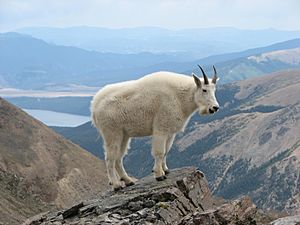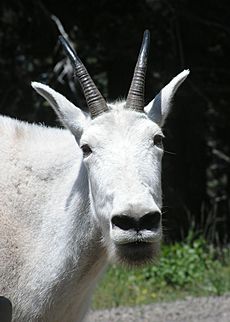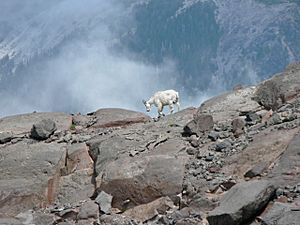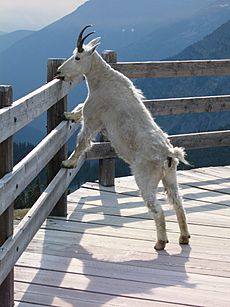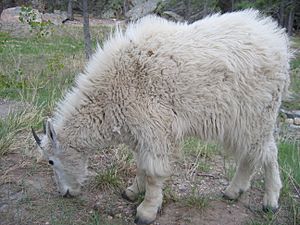Mountain goat facts for kids
Quick facts for kids Mountain Goat |
|
|---|---|
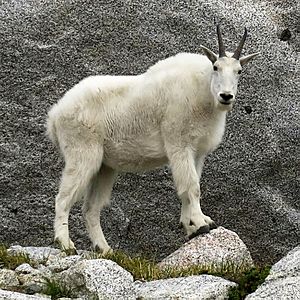 |
|
| Mountain goat in the Cascades | |
| Conservation status | |
| Scientific classification | |
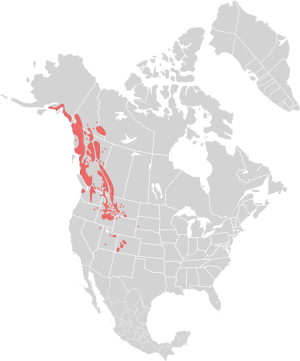 |
|
| Synonyms | |
|
The mountain goat (Oreamnos americanus), also called the Rocky Mountain goat, is a special mammal with cloven hooves. It lives only in the wild, rugged mountains of western North America. These goats are amazing climbers. You can often spot them on steep rock faces, high cliffs, and icy paths.
Mountain goats usually stay in high places. They only go to lower areas if food is scarce or the weather is very bad. Living high up helps them stay safe from predators. These include black bears, brown bears, pumas, and wolves.
Even though it's called a "goat," the mountain goat is not a true goat. True goats belong to the Capra family. Mountain goats are actually more closely related to other animals called "goat-antelopes." These include the European chamois, gorals, takins, and serows.
Contents
What Are Mountain Goats?
The mountain goat is a type of ungulate (a hoofed mammal). It belongs to the Bovidae family, which also includes antelopes and cattle. Within this family, it's part of the Caprinae group. This group includes true goats, wild sheep, and the muskox.
Mountain goats are very closely related to takins from the Himalayas. Both species likely evolved in parallel from an ancient goat ancestor. Scientists believe mountain goats separated from their relatives about 7.5 to 8 million years ago.
The mountain goat is the only living species in its group, Oreamnos. The name Oreamnos comes from Greek words. Óros means "mountain" and amnós means "lamb."
Appearance and Characteristics
Both male and female mountain goats have beards and short tails. They also have long black horns, about 15 to 28 centimeters (6 to 11 inches) long. These horns have rings that show how old the goat is.
Their coats are woolly and grayish-white. They have a soft, thick undercoat and a top layer of long, hollow hairs. This double coat protects them from harsh weather. They can handle winter temperatures as low as -46°C (-50°F). They can also withstand winds up to 160 km/h (100 mph).
Mountain goats shed their extra wool in the spring. They rub against rocks and trees to help it come off. Adult males shed first, and pregnant females shed last.
Male goats are usually larger than females. They stand about 1 meter (3 feet) tall at the shoulder. Males can weigh about 30% more than females. They also have longer horns and beards. Their body length is usually 120 to 179 cm (47 to 70 inches). Their small tail adds another 10 to 20 cm (4 to 8 inches).
Their feet are perfect for climbing steep, rocky slopes. The inner pads of their hooves give them good grip. Their cloven hooves can spread apart for balance. Sharp dewclaws on their feet help prevent slipping. They also have strong shoulder and neck muscles. These muscles help them push themselves up steep hills.
Where Mountain Goats Live
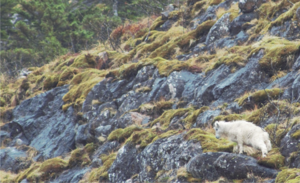
Mountain goats live in the Rocky Mountains and Cascade Range. They are also found in other mountain areas of western North America. Their range stretches from Washington, Idaho, and Montana. It goes through British Columbia and Alberta in Canada. It reaches into the southern Yukon and southeastern Alaska.
British Columbia is home to half of the world's mountain goat population. The farthest north they are found is in the Chugach Mountains of south-central Alaska. People have also introduced mountain goats to other areas. These include Wyoming, Utah, Nevada, Oregon, and Colorado.
Mountain goats are the largest mammals in their high-altitude homes. They can live at elevations over 3,960 meters (13,000 feet). Sometimes they go down to sea level in coastal areas. However, they mostly stay above the tree line all year. They move to different elevations within this range depending on the season. In winter, they might travel several kilometers through forests to find mineral licks.
How Mountain Goats Move
Each day, mountain goats mostly stay on the same mountain face or in the same valley. Their daily movements are about finding food, resting, staying warm or cool, and avoiding danger.
Their seasonal movements depend on their needs. They move to find food, especially mineral licks (places with important salts). Females move to special "kidding" areas to give birth. Males move to "rutting" areas for mating. Weather also affects their movements. For example, they might go to lower, forested areas in winter to find food and shelter.
Young mountain goats might travel the farthest. They sometimes cross forested valleys to move between different mountain areas.
What Mountain Goats Eat
Mountain goats are herbivores, meaning they eat plants. They spend most of their time grazing. Their diet includes grasses, herbs, sedges, ferns, mosses, and lichens. They also eat twigs and leaves from small shrubs and conifer trees in their high-altitude homes.
In zoos, mountain goats can also eat grain, alfalfa, fruits, and vegetables.
Life Cycle and Reproduction
In the wild, mountain goats usually live for 12 to 15 years. Their lives are often limited by their teeth wearing down. In zoos, they can live longer, sometimes 16 to 20 years.
Mountain goats are ready to have babies at about 30 months old. Females in a herd usually become ready to mate at the same time. This happens from late October to early December. During this time, males and females take part in a mating ritual.
Older male goats (billies) will stare at females (nannies) for a long time. They dig special "rutting pits" and sometimes fight each other. These fights look impressive but are usually not very dangerous. Nannies often ignore younger males and prefer older partners. Both males and females usually mate with several partners during this season. After mating season, males and females separate. Nannies form groups of up to 50 animals to raise their young. Adult males often leave and stay alone or with a few other males.
Baby goats, called kids, are born in the spring. This is usually in late May or early June, after about a six-month pregnancy. Nannies give birth to one kid, usually on an isolated ledge. Kids weigh a little over 3 kilograms (7 pounds) at birth. They start running and climbing within hours!
Kids stay close to their mothers for their first year. Nannies protect their young from danger. They stand over them if predators are near. On steep slopes, they position themselves below their kids to stop them from falling.
Staying Safe and Aggressive Behavior
Nannies can be very protective of their space and food. They might fight each other for dominance within the herd. In these fights, they circle each other with their heads lowered, showing off their horns. These conflicts are usually harmless, but can sometimes lead to injury. To avoid a fight, a goat might show a non-aggressive pose by stretching low to the ground.
In areas below the tree line, nannies use their fighting skills to protect themselves and their kids from predators. Predators like wolves, wolverines, lynxes, and bears will attack goats if they get a chance. The cougar, or mountain lion, is a main predator. It is strong enough to take down large adult goats. It is also agile enough to move in the goats' rocky habitat.
Even though their size protects them in high altitudes, nannies must sometimes defend their kids from bald and golden eagles. These large birds can be a threat to young kids. Nannies have even been seen trying to dominate the larger, but more peaceful, bighorn sheep that share some of their territory. In 2021, a mountain goat even killed a grizzly bear in Yoho National Park, British Columbia.
Mountain goats were brought to Washington’s Olympic Mountains in the 1920s. Over time, they became a problem there. They would often bother people to get salt from their sweat. The park did not have enough natural salt licks. One goat even killed a hiker in 2010. Because of this, officials decided to remove them from the Olympic Peninsula. Hundreds of goats were captured and moved to the Cascade Mountains.
Wool
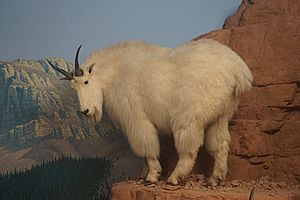
Mountain goats have never been domesticated (tamed) for their wool. However, long ago, pre-Columbian indigenous peoples of the Pacific Northwest Coast used their wool. They collected the wool that wild goats shed in the spring. They then used it for their weaving.
Gallery
-
Mountain goat with kid in Glacier National Park
See also
 In Spanish: Cabra blanca para niños
In Spanish: Cabra blanca para niños



